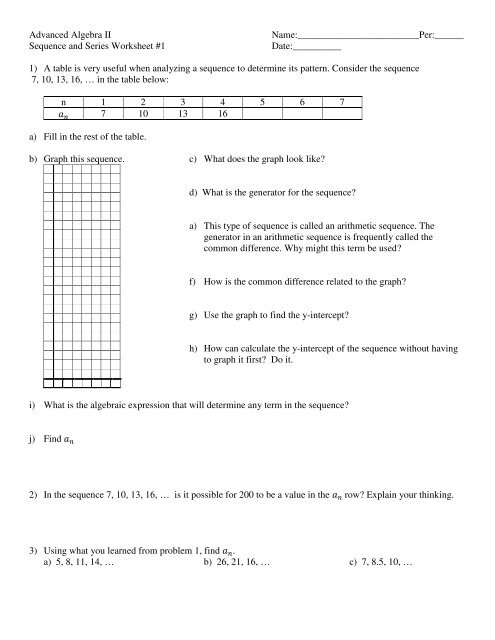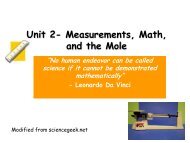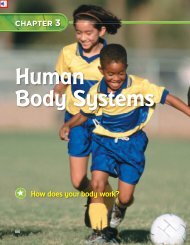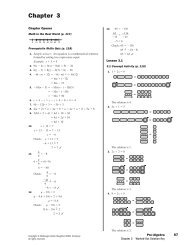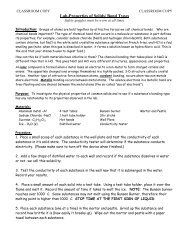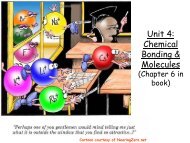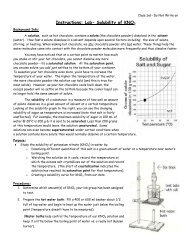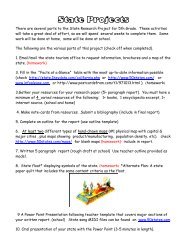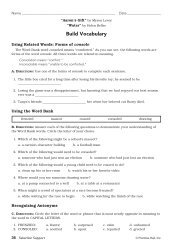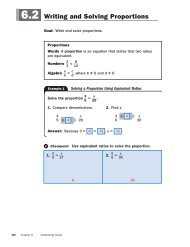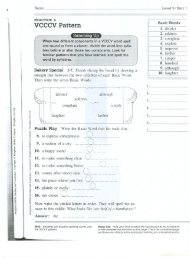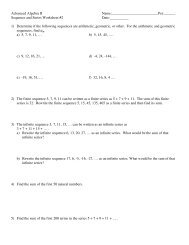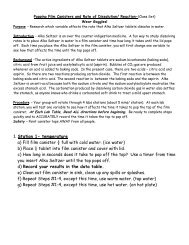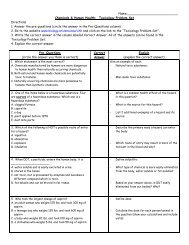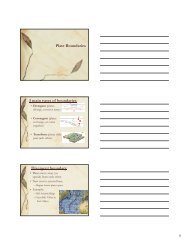Sequence and Series Worksheet #1 Date:______ 1) A table is
Sequence and Series Worksheet #1 Date:______ 1) A table is
Sequence and Series Worksheet #1 Date:______ 1) A table is
Create successful ePaper yourself
Turn your PDF publications into a flip-book with our unique Google optimized e-Paper software.
Advanced Algebra II<br />
<strong>Sequence</strong> <strong>and</strong> <strong>Series</strong> <strong>Worksheet</strong> <strong>#1</strong><br />
Name:_________________________Per:______<br />
<strong>Date</strong>:__________<br />
1) A <strong>table</strong> <strong>is</strong> very useful when analyzing a sequence to determine its pattern. Consider the sequence<br />
7, 10, 13, 16, … in the <strong>table</strong> below:<br />
n 1 2 3 4 5 6 7<br />
7 10 13 16<br />
a) Fill in the rest of the <strong>table</strong>.<br />
b) Graph th<strong>is</strong> sequence. c) What does the graph look like?<br />
d) What <strong>is</strong> the generator for the sequence?<br />
a) Th<strong>is</strong> type of sequence <strong>is</strong> called an arithmetic sequence. The<br />
generator in an arithmetic sequence <strong>is</strong> frequently called the<br />
common difference. Why might th<strong>is</strong> term be used?<br />
f) How <strong>is</strong> the common difference related to the graph?<br />
g) Use the graph to find the y-intercept?<br />
h) How can calculate the y-intercept of the sequence without having<br />
to graph it first? Do it.<br />
i) What <strong>is</strong> the algebraic expression that will determine any term in the sequence?<br />
j) Find <br />
2) In the sequence 7, 10, 13, 16, … <strong>is</strong> it possible for 200 to be a value in the row? Explain your thinking.<br />
3) Using what you learned from problem 1, find .<br />
a) 5, 8, 11, 14, … b) 26, 21, 16, … c) 7, 8.5, 10, …
4) Consider the sequence 3, 6, 12, 24, …<br />
a) Complete the <strong>table</strong> for the sequence.<br />
n 1 2 3 4 5 6 7<br />
3 6 12 24<br />
b) What <strong>is</strong> the generator for th<strong>is</strong> sequence?<br />
c) How many times do you need to multiply the first term in the sequence of 3 by 2 in order to obtain the<br />
value 24 in the sequence?<br />
d) Is there a short cut for doing repeated multiplication? What <strong>is</strong> it?<br />
e) The value found when n = 6 can be obtained by multiplying 3(2)(2)(2)(2)(2). Rewrite th<strong>is</strong> expression<br />
using exponents.<br />
f) What will the representation be for the 100 th term of the sequence?<br />
g) How could you represent ?<br />
5) Using what you learned from problem 4, find for each sequence below.<br />
a) 2, 8, 32, … b) 7, 42, 252, 1512, … c) 3072, 384, 48, 6, …<br />
6) For each of the following sequences, state whether each <strong>is</strong> arithmetic or geometric. If arithmetic or<br />
geometric, write the next 3 terms find <strong>and</strong> find .<br />
a) 4, 9, 14, 19, … b) 24, 12, 6, 3, …. c) 91, 82, 73, 64, …..<br />
d) 1, 4, 9, 16, ….. e) -9.5, -7, -4.5, -2, … f) -4, 8, -16, 32, ….
7) For each of the following sequences, determine if 335 <strong>is</strong> a term in the sequence.<br />
a) = 5n – 30 b) = 6(n – 2) + 78<br />
c) = -15n + 40 d) 3, 7, 11, 15, ….<br />
8) An arithmetic sequence contains the following: = 46 <strong>and</strong> = 25. Find the equation for the sequence<br />
algebraically <strong>and</strong> then determine .<br />
9) Use the pattern below to determine how many tiles the 46 th figure of the sequence would have.<br />
Figure 1 Figure 2 Figure 3 Figure 4<br />
10) Factor Completely<br />
a) 60 110 100 b) 64 27 5 45
11) Use the following functions to answer each of the following.<br />
f(x) = 4 - (8x – 6) g(x) = 3x² - 5x h(x) =<br />
2<br />
x − 5<br />
a) Find g(2). b) Find h(-3). c) Find x if g(x) = 12.<br />
d) Find x if h(x) = 3. e) Find x if g(x) = 2. f) Find x if g(x) = 0.<br />
12) Investigate each function below.<br />
a) 8<br />
b) 3 √4


